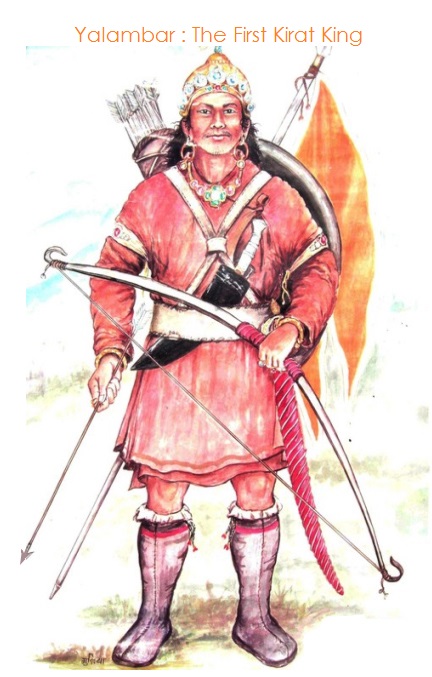The SUNUWARs or SUNWARs are one of the 59 indigenous people listed under the Nepal government’s National Foundation for Development of Indigenous Nationalities (NFDIN) schedule. The word ‘Sunuwar’ is actually an Indo-Aryan Nepali term, but they call themselves ‘Koĩts’ in their mother tongue and are proud to identify themselves as ‘Kirat-Koĩts’. The Kirat-Kõits are one of the Mongoloid tribes (anthropologically: Mongoloid stock). Other terms like Mukhiya or Mukhia are exonyms.
In the past their life style was mostly nomadic like any other neighboring tribes before the advent of the age of agriculture. They preferred dwelling on the Himalayas and rugged hills, river valleys, caves and jungles for easy hunting and food gathering. Till today traces of hunting practices can be found amongst them in isolated areas. Some of them have adopted their title as Sikari ‘Huntsman’ Sunuwar also.
SUNWARs have their own ethnic identity like distinct language, religion, cultural aspects and social customs who inhabiting the eastern hilly region of Nepal at the foot of the Everest massif since centuries before the unification of Nepal in its actual boundaries. They are autochthonous alongside the Ngãku (Sunkoshi) river, Subuku (Tamakoshi) river, Liku (Likhu) Khola, Khimku (Khimti) Khola, Yolung Khola, Molung Khola, and Solung Khola (‘Khola’ Indo-Aryan Nepali etymon ‘rivulet’). Its source – in the Rolwaling Himalayan range – flows to the south.
By administrative division, they dwell in Okhaldhunga, Ramechhap and Dolakha districts of Nepal, politically known as Wallo Kirat was their Kipat, or 'communal land' in the past. Ever since the Kipat lands were abolished with the promulgation of Land Reform Act of 1964. The state then imposed the hierarchical Hindu caste policy of assimilations, among others, Koĩts Sunuwar were also compelled to some of their Kipat lands for the use of Hindu priest. Since, then migration (mainly to the east) took place in several parts of the country in Kathmandu, Sindhuli, Jhapa, Ilam, Panchthar, Taplejung, Terathum, Sunsari, Khotang, Bhojpur and other districts of Nepal and abroad in Darjeeling, Sikkim, Dehradun, Bhutan, South Korea, Japan, UK USA, Canada.
Ongde (Ora Ongde and Purbeli Ongde), katich, Kormoch, Quiticha, Kyaba (Bagale Kyaba, Rarale Kyaba, Tumali Kyaba), Kalang (Kaunifuche and Khaarpangcho), Karshing, Kalikate, Gauracha, Gaudeli, Ngawacha, Chebali, Chhyongpaticha (Khyaungpaticha), Jizicha, Jespucha, Jeticha (Saduwa Jetich and Barawaa Jeticha), Jancha, Jimlung, Tongkucha, Tursucha, Turkucha, Mulicha, sokuch, Rapacha, Rupacha, Rawacha, Laspacha, Yata (Garsi Yata, Bamna Yata, Khokle Yata, Gramsi Yata, Suri Yata), Durbicha , Debbach, Fatich, Susucha, Sochul, Nomlich, Linucha, Dirgach, Bigyach, Thangracha, Dasucha, Bramlich, Lokunch, Bralach, Binich, Yaluncha, Thungucha, Thalocha, Noplicha, Pargach, Ruzich, Lukhicha, Lilucha, Lor(ung), Lopa, Laaram, Susich, Songnaa(Dalmukhi, Bagale, Bhalochan, Bhasakaar), Hetam (Bowola), etc. are some clans of Koĩts and they speak their own mother language is called ‘Koĩts Lo’ which is classified in the Sino-Tibeto-Burman family of languages in linguistic atlas of the world. Of their total population of 55,712, as many as 37, 898 Koĩts speak their mother language, according to Government of Nepal, Central Bureau of Statistics 2011. In India, especially at Sikkim State government has listed Koĩts-Sunuwar language as one of the official language.

Kirat people had ruled the Nepal valley for more than 32 generations immediately after Gopala ‘cow hoarder’ and Mahispala ‘buffalo hoarder’ tribes. The Hopo ‘king’ Yalambar is believed to be their first legendary king and Jite Dasti the last one. And they are famous for their Mundum ‘oral religious text’ amongst them as their history is still unwritten. Sunuwar are originally from Kirat family and their life style, culture, tradition, religion is followed by their traditional Kirat religion, while the religious theology and philosophy is called ‘Kirat Mundhum’. They have their own shamans i.e. Poinbo (male shaman) and Gyami (female shaman) and priest is known as Naso. The shamans and priest perform every custom, ritual, festivals and plays integral role within Sunuwar community.
Sunuwar people celebrate ‘Yele Thoche’ as new year which normally falls on 15th of January each year. They are very rich in their traditional cultures. They have so many traditional feast and festivals. Every traditional feasts and festivals have its own objectives, characteristics and system of celebration. Some greatest traditional festivals are Shyadar Pidar, Gil Pidar, Meserani Pidar, Chhegu Pidar, etc. are important. They celebrate Shyadar Pidar festival in the Day of Buddha Purnima or after 5 days of Buddha Purnima(panchami) according to Nepali calendar. As whole community, they celebrate Meserani Pidar two times per year but individually, they celebrate it any time. They also celebrate ‘Sanshari Pidar’ in beginning of monsoon. They only worship (i) Nature and (ii) thier Ancestor. The Shyanbu (homemade wine of Millet) is importantly needed during any kind of pidar. Some of the Sunuwar people believe themselves as Suryavanshi, family of the Sun.
Daura-Suruwal, Bhoto, Jalirumal, Jhammari and Topi are the traditional Sunuwar costume for men and Gunyou-Cholo, Bhoto, JaliRumal, kammari,Patuka, Charani-aathaani, Dhungri, Phuli, Tilahari, Chepte, Suduk, Bulaki, Dragon Head Bracelet, Bunga Bala, Jun (Moon), Jantar (Amulet) are the traditional Sunuwar costume for female.
In the time of Shah Dynasty, because of excellent skills in administrative works, armed service and other territorial works Sunuwar people have been granted the title of ‘Mukhiya’. Still some Sunuwar peoples add the title ‘Mukhiya’ at the end of their name. It is also believe that the group ‘Jirel’ and ‘Surel’ are also the sub-group of Sunuwar, but now Jirels are recognized as an independent indigenous. On other hand, some Surels believe themselves as Sunuwar and still some of them put their last name as Sunuwar.
Useful links:
National Foundation For Development of Indigenous Nationalities, Nepal
Nepal Federation of Indigenous Nationalities
